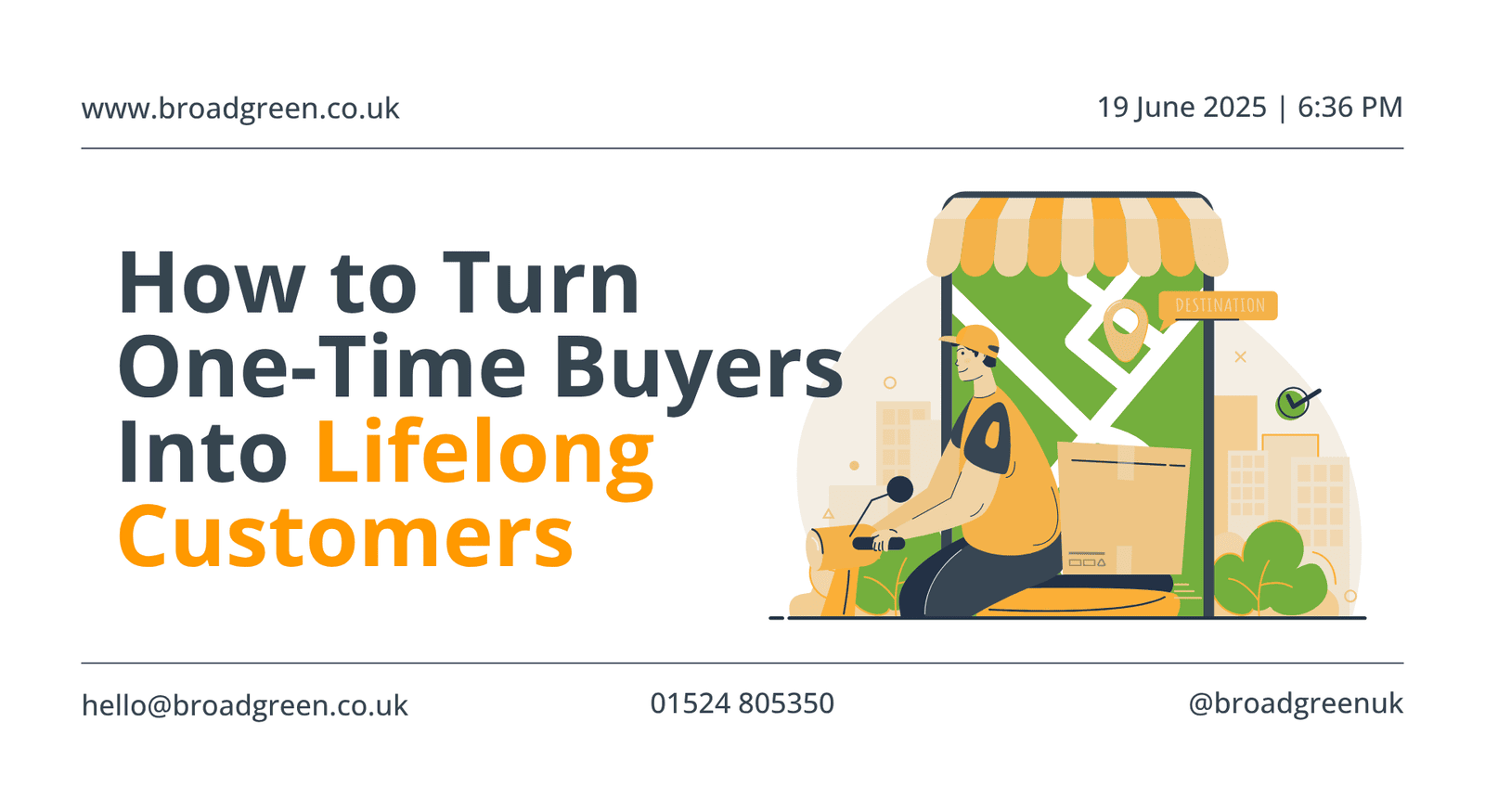
Why most sellers are throwing money away (and how the smart ones are building customer loyalty that actually lasts)
Let me tell you about Sarah, an Amazon seller I met last month. She was frustrated beyond belief. Every month, she'd spend thousands on advertising to bring new customers to her skincare products. They'd buy once, maybe leave a review, then disappear forever.
Meanwhile, her competitor – who she knew had inferior products – was somehow building a loyal following. Customers kept coming back, month after month. His revenue was growing while hers stayed flat.
Sarah's problem isn't unique. In fact, it's the biggest challenge facing Amazon sellers today.
Here's the shocking truth: 68% of Amazon customers never buy from the same seller twice. Think about that for a moment. More than two-thirds of the people you're paying to acquire will never give you another penny.
But here's what makes this even more painful – the cost of finding a new customer on Amazon has tripled in the past two years. You're paying more and more for customers who buy less and less.
The sellers who are thriving? They've figured out how to flip these odds completely. They're turning strangers into repeat customers, one-time buyers into brand advocates, and casual shoppers into subscription customers.
Today, I'm going to show you exactly how they're doing it.
Why Amazon Makes Customer Loyalty So Difficult (And What You Can Do About It)
Why Amazon Makes Customer Loyalty So Difficult (And What You Can Do About It)
Let's be honest about something: Amazon wasn't built to help you create customer relationships. It was built to keep customers loyal to Amazon, not to you.
Think about it. When someone buys from your website, you get their email address, their purchase history, their preferences. You can market to them directly, send them special offers, build a real relationship.
On Amazon? You get almost nothing. Amazon owns the customer data, controls the communication, and constantly shows your buyers alternatives from your competitors.
It's like trying to build a relationship with someone while standing in a crowded room where everyone's shouting louder than you.
But here's what successful sellers have discovered: you don't need to fight Amazon's system. You need to work within it intelligently.
The numbers that should wake you up:
- It costs 5-7 times more to find a new customer than to keep an existing one
- Repeat customers spend 67% more than first-time buyers
- Just a 5% increase in customer retention can boost your profits by up to 95%
- Yet 73% of Amazon sellers have never even calculated their customer lifetime value
Sarah, the seller I mentioned earlier? Once she implemented the strategies I'm about to share with you, her repeat purchase rate jumped from 8% to 42% in just six months. Her revenue didn't just grow – it exploded.
The Review Game: How to Turn Your Biggest Challenge Into Your Secret Weapon
The Review Game: How to Turn Your Biggest Challenge Into Your Secret Weapon
Everyone talks about getting more reviews. But what most sellers miss is that reviews aren't just about attracting new customers – they're about keeping the ones you already have.
Here's something that might surprise you: customers who leave reviews are three times more likely to buy from you again. And when you respond thoughtfully to their reviews? That likelihood jumps to nearly 90%.
Let me share the approach that's working for smart sellers right now.
The Smart Way to Get More Reviews
Forget begging for reviews. The best sellers use what I call the "helpful friend" approach. Instead of asking for reviews immediately after purchase, they focus on being genuinely helpful first.
Here's the sequence that works:
Day 3 after delivery:Send a message checking that everything arrived safely. Include a helpful tip about using the product. Don't mention reviews at all.
Day 7:Share something valuable – care instructions, recipe ideas, styling tips, whatever makes sense for your product. You're building goodwill, not asking for anything.
Day 14: Now you can make a soft review request. But instead of "please leave a review," try something like: "How has the product been working for you? If you're happy with it, a quick review would really help other customers make their decision."
Day 30: Follow up with complementary product suggestions or additional tips. Keep the relationship going.
This approach feels natural to customers because you're being helpful first, not pushy.
How to Respond to Reviews Like a Pro
Most sellers either ignore reviews completely or respond with generic templates. Both approaches miss a huge opportunity.
When someone leaves a negative review, don't panic. See it as a chance to show future customers how you handle problems. Here's what works:
For negative reviews:
- Respond within 24 hours (speed matters more than you think)
- Acknowledge their specific concern – never use cookie-cutter responses
- Offer a real solution publicly, then follow up privately
- Thank them for helping you improve
For positive reviews:
- Thank them for the specific details they mentioned
- Share their enthusiasm genuinely
- If appropriate, mention how their feedback helps other customers
One seller I work with turned a scathing 1-star review into his most effective sales tool. A customer complained that his coffee grinder was "too loud for early morning use." Instead of getting defensive, he responded: "Thanks for this feedback! You're absolutely right – this is a powerful commercial-grade grinder that's definitely not whisper-quiet. I've added a note to the listing so early birds know what to expect. For anyone looking for serious grinding power and doesn't mind a bit of noise, this machine will serve you perfectly for years."
The result? That response got more helpful votes than most 5-star reviews, and his sales actually increased because people knew exactly what they were getting.
Creating Experiences That Keep Customers Coming Back
Creating Experiences That Keep Customers Coming Back
Here's something most sellers get wrong: they think customer experience starts when someone clicks "buy now." But the experience actually starts the moment someone lands on your product page.
Every interaction either builds trust and loyalty or erodes it. Let me show you how to make sure you're always building.
Your Product Listing Is a Promise
Your listing isn't just a sales tool – it's setting expectations for the entire customer experience. When those expectations are met or exceeded, customers trust you. When they're not, you get returns, negative reviews, and one-time buyers.
The sellers with the highest customer satisfaction rates use their listings to be completely transparent. They show the product from every angle, include size comparisons, address common concerns in their bullet points, and use their A+ content to tell the full story.
Yes, this might mean some people don't buy from you. But the people who do buy are much more likely to be happy with their purchase – and to buy again.
The Post-Purchase Experience That Builds Loyalty
Most sellers think their job is done once Amazon ships the product. That's exactly backwards. The real relationship building starts after the sale.
Smart sellers create what I call a "customer success journey." Here's what that looks like:
Immediately after purchase: Send a warm welcome message with your brand story and what makes your product special.
When the product arrives: Check in to make sure everything's perfect. Include care instructions or tips for getting the best results.
One week later: Share additional value – recipes, workout routines, styling ideas, maintenance tips, whatever fits your product category.
Two weeks later: Ask how the product is working and if they have any questions. This is when you can make that soft review request.
One month later: Suggest complementary products or share seasonal tips. Keep the relationship alive.
This journey turns a transactional interaction into an ongoing relationship. And relationships drive repeat purchases.
Your packaging might be the only physical touchpoint you have with customers. Most sellers see it as a necessary evil – something to get products from point A to point B safely and cheaply.
The best sellers see packaging as an opportunity to make a lasting impression.
I'm not talking about expensive custom boxes (though those can work). I'm talking about small touches that show you care:
- A handwritten-style thank you note
- Care instructions or quick setup guides
- Your brand story on a simple insert
- QR codes linking to helpful video content
- Sustainable packaging that customers appreciate
One seller added a simple insert with "5 Creative Ways to Use Your New [Product]" and saw her repeat purchase rate increase by 23%. It cost her 12 pence per order.
The Art of Getting Customers to Buy Again (Without Being Able to Email Them)
The Art of Getting Customers to Buy Again (Without Being Able to Email Them)
This is where things get interesting. How do you encourage repeat purchases when you can't directly contact customers?
The answer lies in understanding Amazon's ecosystem and working within it strategically.
Subscribe & Save isn't just for household essentials anymore. Smart sellers are using it across all kinds of categories by thinking creatively about replenishment cycles.
The key is pricing it right. Your Subscribe & Save price should offer real value – typically 15-20% off the one-time purchase price. This isn't just about being competitive; it's about creating a clear incentive for customers to commit to regular purchases.
But here's the secret most sellers miss: you need to actively promote your Subscribe & Save option. Use sponsored ads to target people who've already bought your products. Create bundles that make subscription more attractive. Monitor delivery frequencies and adjust based on customer behaviour.
One supplement seller I work with saw his subscriber base grow by 300% in six months by creating educational content around "optimal dosing schedules" that naturally led to Subscribe & Save recommendations.
Since you can't follow up with customers directly, you need to be strategic about encouraging additional purchases through Amazon's tools.
The most effective approach is creating what I call "product ecosystems" – collections of products that naturally work together. Instead of selling individual items, you're solving complete problems.
A kitchen equipment seller might bundle a stand mixer with specialty attachments and recipe books. A fitness brand might group resistance bands with workout guides and accessories. A skincare company might create morning and evening routines with complementary products.
Then use Amazon's tools to make these connections visible:
- Optimize your "frequently bought together" suggestions
- Use your Brand Store to showcase complete solutions
- Create themed bundles with clear value propositions
- Use sponsored product ads to show complementary items to existing customers
Amazon's Brand Follow feature is underused by most sellers, but it's incredibly powerful for retention. When customers follow your brand, they see your new products first and get notifications about your launches and deals.
The trick is giving people a reason to follow you beyond just wanting to sell them things. Share useful content, behind-the-scenes stories, seasonal tips, or exclusive previews. Make following your brand feel like joining a community, not signing up for sales pitches.
Real Results from Real Sellers
Real Results from Real Sellers
Let me share three examples of sellers who transformed their businesses by focusing on customer retention.
The Supplement Success Story
James was selling vitamins and struggling with the commoditized nature of his market. Everyone was competing on price, and his margins were getting thinner every month.
Instead of joining the race to the bottom, he focused on customer education and retention. He created detailed dosing guides, tracked customer reorder patterns, and optimized his Subscribe & Save offerings.
Within eight months, his repeat purchase rate went from 11% to 47%. More importantly, his average customer lifetime value increased by over 400%. He was able to spend more on advertising because each customer was worth so much more, which helped him dominate his category.
The Home Goods Transformation
Lisa sold home decor items and was frustrated by negative reviews from customers who said products looked different than expected.
Instead of defending her products, she completely redesigned her customer experience. She added lifestyle photography showing products in real homes, created detailed measurement guides, and implemented a proactive customer service approach.
Her return rate dropped by 60%, her average review rating improved from 3.9 to 4.7 stars, and her customer retention rate increased by nearly 300%. Customers started leaving reviews specifically praising how "accurate" her listings were.
The Fashion Brand Revolution
Mark was selling men's casual wear in a crowded market. He couldn't compete with fast fashion on price, so he decided to compete on customer experience instead.
He created detailed sizing guides with customer photos, developed a signature packaging experience, and built style guides around his products. He also started a brand community where customers could share photos and styling tips.
Within a year, his average order value increased by 85%, his customer lifetime value tripled, and he became one of the top sellers in his category. Customers started specifically seeking out his brand instead of just shopping for generic products.
Where to Start (Because I Know You're Thinking "This Sounds Like a Lot")
Where to Start (Because I Know You're Thinking "This Sounds Like a Lot")
Look, I get it. You're probably reading this thinking, "Great advice, but where the hell do I even begin?"
Here's the thing - you don't need to implement everything at once. In fact, trying to do it all immediately is the fastest way to get overwhelmed and give up.
Start with the low-hanging fruit:
Pick your best-selling product and focus on that first. Set up the review request sequence I mentioned earlier. Create one really good packaging insert. Write proper responses to your existing reviews.
That's it for week one.
Once you've got that working, expand to your next product. Then the next. You'll be amazed how much difference these small changes make.
The mistake most sellers make? They try to overhaul everything overnight. Then they get frustrated when they can't keep up with all the moving parts.
Smart sellers pick one thing, do it well, then move on to the next. Boring? Maybe. Effective? Absolutely.
James, the supplement seller I mentioned, started with just his top protein powder. He got his retention system working perfectly for that one product before expanding. Six months later, he was applying the same approach across his entire range - and seeing those 400% lifetime value improvements.
The point is: start small, get it right, then scale. Your bank account will thank you.
Why Most Sellers Will Never Do This (And Why That's Great for You)
Why Most Sellers Will Never Do This (And Why That's Great for You)
Here's the uncomfortable truth: most Amazon sellers will read this, nod along, maybe even bookmark it for later – and then do absolutely nothing.
They'll go back to obsessing over keyword rankings, launching new products, and fighting price wars with competitors. They'll keep treating customers like transactions instead of relationships.
Why? Because building customer retention systems requires patience, systematic thinking, and consistent execution. It's not as exciting as launching a new product or as immediate as running a flash sale.
But that's exactly why it's such a powerful competitive advantage for the sellers who actually implement these strategies.
While your competitors are chasing the next shiny object, you can be building a business that generates predictable, recurring revenue from customers who genuinely want to buy from you again and again.
What Happens Next?
What Happens Next?
Look, you now know the strategies that separate successful Amazon sellers from everyone else. You understand why customer retention is the fastest path to sustainable growth on Amazon, and you have a roadmap for implementation.
But knowing and doing are two very different things.
The sellers who succeed aren't necessarily the smartest or the ones with the best products. They're the ones who consistently execute proven strategies while their competitors are still figuring things out.
If you're serious about transforming your Amazon business – not just reading about it, but actually doing the work – then you need to make a decision right now.
You can try to implement everything yourself, spending the next six months figuring out what works and what doesn't, making expensive mistakes along the way.
Or you can work with people who've already solved these problems for hundreds of other sellers.
The bottom line: Customer retention is the difference between building a real business and just having an expensive hobby. You can spend months trying to figure this out yourself, or you can get expert help from people who've already cracked the code.
While your competitors are still fighting over new customers, you could be building relationships that last for years.
Don't leave your Amazon success to chance. Our team of seasoned experts is ready to help you build customer relationships that drive repeat sales and long-term growth.
📞 Call us: 01524 805 350
✉️ Email: hello@broadgreen.co.uk
🏢 Visit us: 166 Lancaster Rd., Carnforth, Lancashire, LA5 9EF
Transform your Amazon business with Broadgreen – where data-driven strategies meet marketplace expertise.

